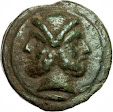rrd top 10 2023
12/24/2023
This year has a variety of treasures. The order of all
but #1 could change depending on how you value rare vs pretty and coins vs
scale weights. It is hard to believe I bought my first Julius Caesar portrait
denarius and it did not make the top 10. I picked up two scale weights from the
David Hendon auction in January and only one made top 10.
I had three misses that would have been highlights, but
did not come my way. I will show those later.
1.
100 As Roman stone Weight with handle. 2ND-3RD CENTURY
A.D. Of biconical form and bearing an engraved letter 'C' to the top face;
slightly concave base; iron handle showing some corrosion. 13 3/4 in. (30.3 kg = 67 #, or about a bushel
of wheat), 35 cm wide).
2. Two Libra (As) Commercial Weight
EASTERN
MEDITERRANEAN/AEGEAN. Late Hellenistic to Roman Imperial Period. Cast PB
Dupondius Weight (92x90mm, 704.00 g).
Obverse - Blank in
simple raised molded frame; | | (mark of weight) inlaid in copper /
Reverse - Blank,
but for etched name ANTONINVS.
Brown patina, some
marks.
3.
Moneyer issues of Imperatorial Rome. C. Vibius Varus.
42 BC. AR Denarius Rome mint.
Laureate and
bearded head of Hercules right
Minerva standing
right, holding spear and Victory; shield set on ground to right.
Light golden toning. Good VF. (17.5mm, 3.91 g, 9h). Crawford 494/37;
4.
Etruria, Volterrae Æ As circa 217-215,
Obv - Janiform
head of Culsans wearing pointed cap.
Rev - Club; in
field r., mark of value: I, Etruscan ethnic 'velaθri' around.
62.00 mm., 143.76
g.
Haeberlin pl. 83,
7.
5.
Cast Uncia, Greek Italy. Uncertain Umbria or Etruria.
AE, c. 3rd century BC.
Obv. Club. / Rev.
Dot.
Vecchi ICC 200;
Haeb. pl. 81,42.43.
11.49 grams, 23.0
mm.
R. Rare.
Attractive earthy green patina. About EF.
I have several 2 dot coins of this series, both large and small series. I have wanted this type for a while.
6.
Roman Republic, Aes grave, Roma / Roma series, Semis,
269 - 240 BC, Rome mint
D\ Head of Mars in
Corinthian helmet, facing right, under S in retrograde.
R\ Head of Mars,
facing left, under S.
Weight 124.50
grams, Diameter 52 mm.
BB+. Green Patina
Cataloguers have
different names for the heads on this coin. Mars and Minerva are the most
common, but juvenile head and Head of warrior hero were also used.
7. 24 Nomismata, NKΔ, Byzantine Empire Æ Weight. Circa 5th-7th Century AD. Silver inscription inlay: + ΑΓΙΑ ΜΑΡΙΑ ΒΟHΘΙCΟΝ on raised circle enclosing monogram between two crosses over denominational number NKΔ; CE - YX - AP - IC in four corners / Blank. Unpublished in the standard references. A similar weight (N OB = 72 nomisma) is on the cover of Collections du Musée d’art et d’histoire - Genève, Geneva 2015, p. 38, 109.10g, 39mm. Extremely Fine
This imposing weight is part of a series that carries two silver inlayed invocations: ΑΓΙΑ ΜΑΡΙΑ ΒΟHΘΙCΟΝ (= Saint Mary help us) and in the four corners: ΘE – YX – AP – IC (= the grace of God).
8.
30 Nomismata, ΛN, Bronze Coin Weight, Romano-Byzantine,
4th-5th centuries CE.
Ov - Two facing
imperial busts within arched distyle shrine, letters ΛN below. Brown surfaces,
minor traces of silver. / Rev - Blank.
117 grams; 41mm
Diameter, 10 mm thick
From the David
Hendin Collection, a few minor marks from usage.
9.
Skythia, Olbia. Cast bronze coin, ca. 470-460 BC.
Obverse: Head of
Athena left, wearing crested Attic helmet; to left, dolphin upward; all within
incuse circle. Reverse: Wheel with four spokes; [magistrate's name Π-A-Y-Σ
around].
Extremely Rare -
just a few specimens known. Green patina. Very Fine.
65.75 grams / 46 dia X 8 mm
10.
BYZANTIUM. Round commercial weight. AE 6 Unciae ø 48mm
(152.82g). ca. 6th century A.D. Bronze weight with profiled edge. Engraved on
the top and provided with metal inlays: Two squares placed over corners with
head inlays. Circumferential ΘEOV XAPIC ("God's Grace"). Inside cross
and Γ (= Uncia) - S (= 6). The inscription inlaid in silver. Very nice
specimen!
ΘEOV XAPIC: Gottes Gnaden, German; God's Grace, English; Gracia de Dios, Spanish
.jpg)



















